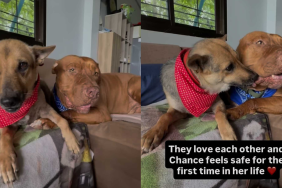Bloat–also called gastric torsion or gastric dilation volvulus–is a life-threatening condition that requires immediate action. When deep-chested or large-breed dogs play immediately after eating a large meal, they run the risk of literally twisting their stomachs. This will pinch closed the entrance and exit of the stomach (the gastroesophageal junction and the duodenum) and allow gas to build up inside the stomach with nowhere to go. The dog is unable to belch or vomit. Other problems, such as dehydration, circulatory shock, cardiac arrhythmias, and peritonitis, can accompany bloat.
There is no real first aid that can be performed on dogs with bloat. The only option is to immediately get the dog to the vet, who may be able to pass a rubber tube through the mouth into the stomach to relieve the pressure. While this may relieve the immediate danger, surgery may still be required to correct the problem.
Time is truly of the essence. Nearly 50 percent of dogs with bloat die from the condition.
Symptoms
Be alert to these symptoms, especially if they occur just after the dog has eaten and exercised:
- Pacing, retching, salivation, or attempts to vomit with no result
- Enlargement of the abdomen (the dog may whine when the belly is pressed)
- Tapping the abdomen produces a sound like a hollow drum
- Lethargy, walking with legs stiff or a hanging head
- Weak pulse and rapid, labored breathing, with pale gums and tongue (this is late-stage bloat, when shock can occur at any time)
When it’s time to see a vet
Signs of bloat require immediate action on your part–even if you’re only operating on suspicion instead of certain knowledge. If your dog is stricken when your vet’s office is closed, take him to the nearest emergency facility.
What’s next
Your vet will make an assessment of the danger right away. If surgery is required, it will most likely be performed immediately if the veterinary facility has the capability. If the initial pressure has been relieved from a tube being passed into the stomach, you will have a bit more time to address the situation, but the remedy must still be immediate.
How to prevent bloat
Dogs that are saved through nonsurgical intervention still have as high as a 70 percent chance of another episode occurring anytime. The incidence of relapse–even the incidence of a first episode–can be lowered by taking some of the following steps:
- Do not allow the dog to drink water one hour before or after a meal.
- Divide food into three daily feedings instead of one large meal.
- Don’t provide large bowls of water. Instead, refill a smaller bowl more frequently so the dog does not get dehydrated but also does not drink too much at one time.
- Do not let the dog exercise strenuously after eating–wait at least two hours.









